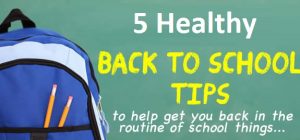 It’s been a great summer, but it’s time to get everyone back in the groove of classes, sports practice — and getting up early again. Here are some tips to help your kids make a healthy transition back to school.
It’s been a great summer, but it’s time to get everyone back in the groove of classes, sports practice — and getting up early again. Here are some tips to help your kids make a healthy transition back to school.
1. Get bedtimes on track, and tidy up the sleep hygiene.
In the summer, when it’s light after 10 p.m., it’s easy for bedtimes to slip. But with early school wake-up calls coming, it’s key for children and teens to get to bed so they get enough quality sleep. Pediatricians recommend that children age 6 to 12 get 9 to 12 hours of sleep a night, and that teens get 8 to 10 hours a night.
Here are some tips to help children and teens get the sleep they need when they return to school.
-
Power off the devices.
-
Consider darkening shades. The clock says it’s bedtime, but it’s still light out. That can interfere with a child’s sleep. Darkening shades can block out distracting light and help your child drift off more easily.
-
Ease off caffeine. Your child or teen should stop drinking anything with caffeine, including sodas and energy drinks, after noon. That way, by bedtime, the stimulant will be out of their system.
2. Check your young student’s eyes.
Good vision is critical to children’s success in the classroom. Some signs there could be issues, can include:
-
Recurring headaches while reading or using digital devices
-
Sitting too close to a TV screen
-
Squinting when viewing things in the distance, like a whiteboard or a ball in gym class
-
Losing place while reading, or slipping behind in reading ability
-
Poor concentration
If you have a child who wears glasses or contact already make sure their prescription is up to date. Vision screening can be done at a child’s annual well-child exam.
3. Make sure backpacks fit well.
As schoolkids get older, they tend to carry heavier books. A load of books with a laptop can weigh as much as 30 pounds. That can spell shoulder, neck, and back strain for young people, and affect their posture.
Make sure your child’s backpack fits well, with padding on the shoulder straps that can be loosened and tightened to ensure a snug fit depending on the contents. Make sure the backpack is always worn with both straps over both shoulders, not one slung over one arm, which adds to the pressure on that arm.
Some parents are switching to rolling backpacks, which can definitely ease the load on young shoulders.
4. Eat a Nutritious Breakfast
